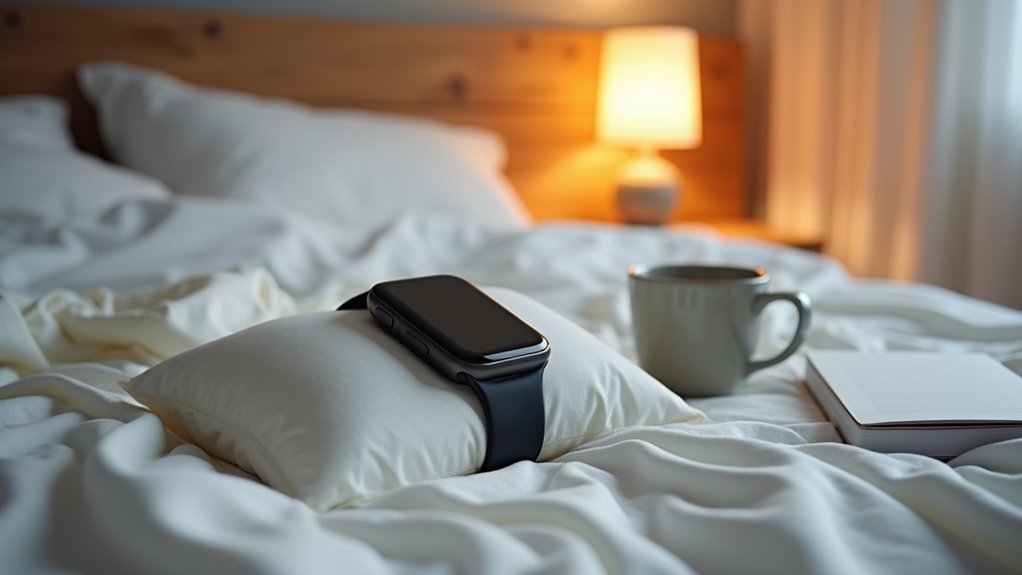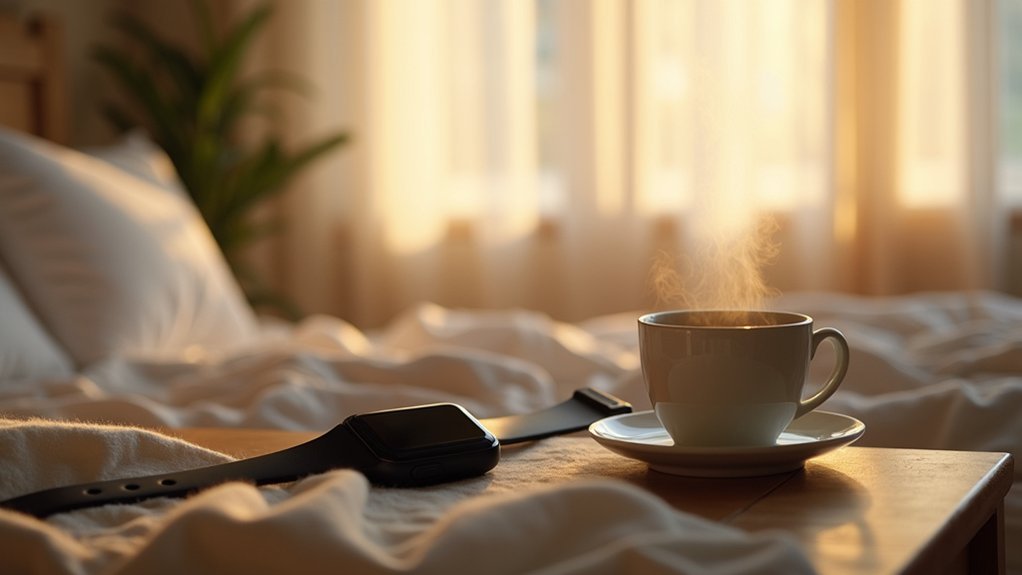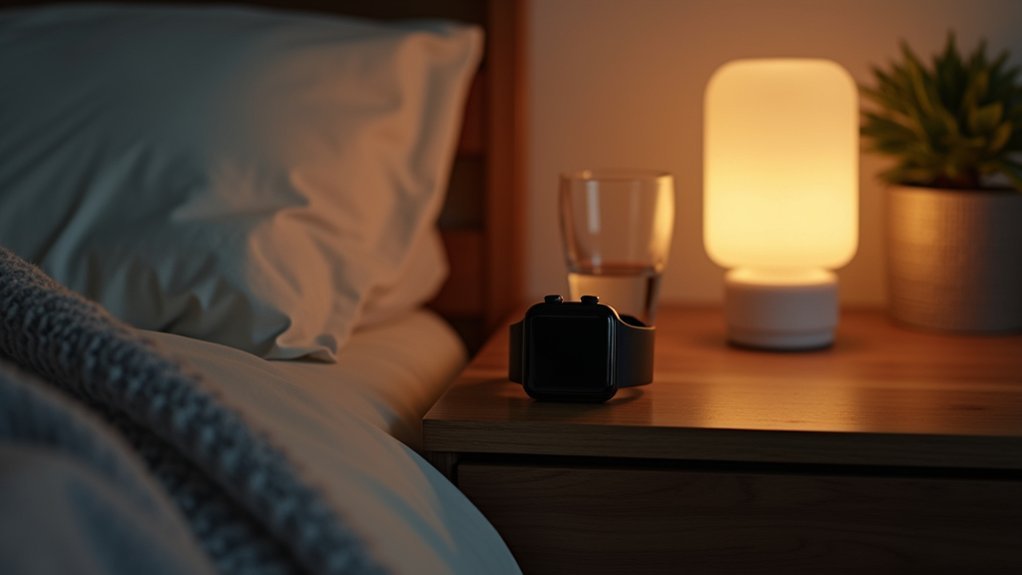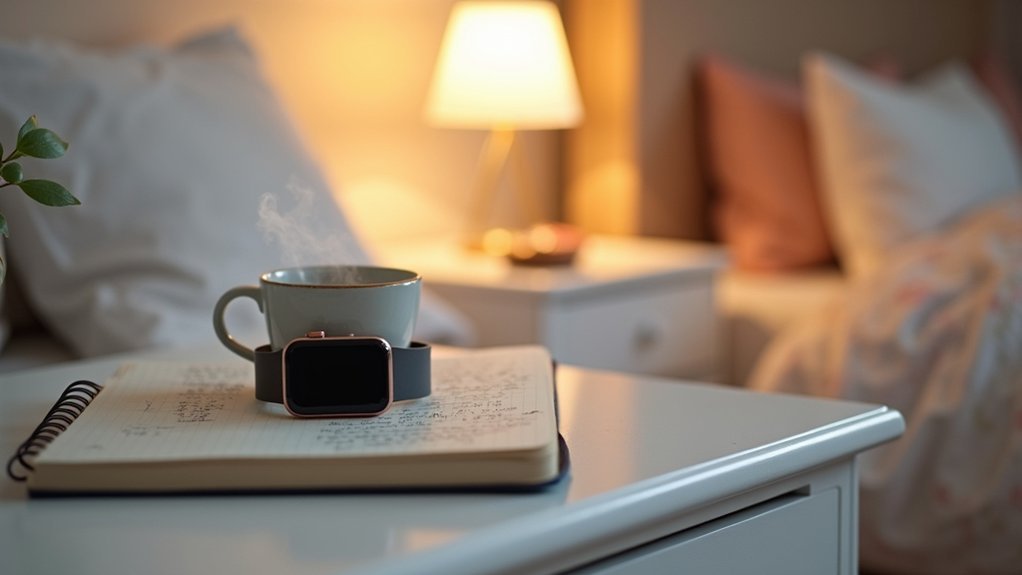You can dramatically improve your sleep quality by choosing an accurate smartwatch like the Google Pixel Watch, ensuring proper fit 1-2 finger widths above your wrist bone, and enabling heart rate variability monitoring for deeper insights. Use smart wake-up features during light sleep phases, focus on weekly trends rather than nightly data, and combine sleep metrics with environmental factors like room temperature. Don’t obsess over daily scores—trust your body while leveraging these advanced optimization strategies.
Choose the Right Smartwatch for Sleep Tracking Accuracy
When selecting a smartwatch for sleep tracking, you’ll encounter devices that vary dramatically in their ability to accurately monitor your nightly rest.
Google Pixel Watch currently shows the highest overall accuracy among consumer wearables, while Oura Ring Gen 3 excels at precisely identifying light, deep, and REM sleep stages.
Google Pixel Watch leads in overall sleep tracking accuracy while Oura Ring Gen 3 dominates sleep stage identification precision.
If you’re considering popular options, understand their limitations: Fitbit Sense 2 overestimates light sleep and underestimates deep sleep, while Apple Watch Series 8 underestimates both awake periods and deep sleep.
Look for devices that combine multiple sensors—accelerometers, heart rate monitors, and SpO2—with machine learning algorithms.
These features greatly improve sleep stage detection compared to single-sensor devices that only track basic movement patterns. The Oura Ring Gen 4 demonstrates exceptional accuracy by matching polysomnography sleep lab test results, setting a new standard for consumer sleep tracking devices.
Optimize Your Device Settings for Better Sleep Detection
You’ll want to enable automatic sleep detection on your smartwatch to guarantee it consistently captures your sleep data without requiring manual intervention each night.
This feature uses your device’s sensors and algorithms to recognize when you’ve fallen asleep, eliminating the risk of forgetting to activate sleep mode manually. For devices that struggle with automatic detection, you can manually activate sleep mode by adjusting your sleep schedule settings to a later time, which forces the watch to begin monitoring your sleep patterns.
Additionally, you should update your smartwatch’s firmware regularly, as these updates often include improvements to sleep tracking algorithms and may add new sleep stage detection capabilities.
Enable Automatic Sleep Detection
Most smartwatches come equipped with automatic sleep detection capabilities that remain dormant until you activate them through your device’s health or sleep app.
Navigate to your device-specific app like Samsung Health or Apple’s Sleep app, then locate the settings section. You’ll find toggles for “Sleep Tracking” and “Blood oxygen during sleep” – enable these features for thorough monitoring.
Ensure your smartwatch fits snugly on your wrist so sensors can accurately detect sleep stages and movements.
For advanced detection including snore monitoring and oxygen level tracking, turn on all relevant switches within your app’s sleep settings. Galaxy Watch users can access comprehensive sleep data the next morning through the Sleep tile by swiping left on the watch Home screen.
Many devices can automatically start tracking once they detect you’ve fallen asleep through movement and activity sensors, eliminating the need for manual intervention.
Update Firmware Regularly
Keeping your smartwatch firmware updated forms the foundation for reliable sleep tracking performance. Regular updates enhance sleep detection algorithms by incorporating advanced data analysis techniques, resulting in more accurate monitoring of your sleep patterns.
You’ll receive improved movement tracking capabilities and new features that provide deeper insights into your sleep quality.
Firmware updates fix bugs that might interfere with sleep functions, guaranteeing your device captures complete sleep data throughout the night. These updates optimize overall performance, making your smartwatch more responsive during sleep monitoring sessions.
Updated firmware also guarantees compatibility with health apps and other devices, allowing you to create an all-encompassing sleep analysis system that helps you understand and improve your sleep habits effectively. Modern smartwatches primarily rely on accelerometry and photoplethysmography to estimate sleep patterns, making accurate sensor calibration through firmware updates essential for precise measurements.
Ensure Proper Fit and Placement for Reliable Data

Proper placement transforms your smartwatch from a basic sleep monitor into a precision tracking device that delivers consistently accurate data.
Position your device 1-2 finger widths above your wrist bone, closer to your forearm rather than directly on bone structure. This placement improves blood flow detection and prevents sensor interference that can skew heart rate and movement readings.
Position your smartwatch 1-2 finger widths above the wrist bone on your forearm for optimal sensor accuracy and blood flow detection.
Wear your smartwatch snugly enough to maintain skin contact without restricting circulation or causing discomfort. The strap shouldn’t leave marks but must prevent sliding during sleep.
Clean, dry skin optimizes sensor functionality, while lotions or excessive sweating can create interference. Modern devices incorporate heart rate monitoring alongside movement detection to provide more comprehensive sleep analysis than older accelerometer-only models.
Consistency matters most—wear your device in the same position every night. This allows calibration over time and helps algorithms better interpret your individual sleep patterns for more reliable data.
Enable Heart Rate Variability Monitoring for Sleep Quality Insights
Beyond basic heart rate tracking, your smartwatch’s heart rate variability (HRV) monitoring reveals deeper insights into your sleep quality and recovery patterns. HRV measures time intervals between heartbeats, reflecting your autonomic nervous system’s balance. Higher HRV indicates better cardiovascular health and restful sleep, while low HRV suggests poor recovery and sleep disturbances.
| Sleep Stage | HRV Level | What It Means |
|---|---|---|
| Deep Sleep | High | Strong parasympathetic activity, ideal recovery |
| Light Sleep | Moderate | Shifting autonomic state |
| REM Sleep | Lower | Sympathetic dominance, active brain recovery |
| Awake | Variable | Stress and lifestyle factors influence patterns |
| Poor Sleep | Consistently Low | Impaired autonomic function, inadequate rest |
Enable HRV tracking to identify sleep disruptions, understand how stress affects your rest, and receive personalized recommendations for improving sleep quality through lifestyle adjustments. For optimal results, take morning measurements consistently after waking to establish baseline patterns and track improvements over time.
Use Smart Wake-Up Features to Reduce Morning Grogginess

While your smartwatch monitors sleep stages throughout the night, its smart wake-up feature can dramatically reduce that groggy, disoriented feeling you experience when jarred awake from deep sleep.
This feature uses accelerometer and heart rate data to identify ideal wake times during light sleep or REM phases within a 10-30 minute window before your alarm.
You’ll want to set an appropriate wake window and wear your device consistently for better calibration.
Current devices show varying accuracy—Oura Ring detects wakefulness about 57% of the time, while Apple Watch manages around 26%.
Though not perfect, studies suggest users experience decreased morning grogginess when woken during lighter sleep stages. Most devices overestimate total sleep time by 10%, which can affect how the smart wake-up feature calculates your sleep cycles.
Remember to pair this feature with good sleep hygiene and consistent sleep schedules for maximum effectiveness.
Track Weekly Sleep Patterns Instead of Focusing on Single Nights
Single nights of poor sleep can send you spiraling into unnecessary worry, but your smartwatch’s real power lies in revealing weekly patterns that paint a much clearer picture of your sleep health.
Focus on aggregated data rather than obsessing over individual nights, as weekly trends filter out anomalies from stress or illness.
Your smartwatch can identify consistent issues like insufficient deep sleep or irregular bedtimes that single-night data might miss.
Look for patterns in sleep stages, efficiency scores, and heart rate variability across seven days. These insights help differentiate between occasional bad nights and chronic problems requiring intervention.
Use weekly reviews to make sustainable lifestyle adjustments and set realistic goals. This approach encourages gradual improvements rather than reactive fixes that rarely stick.
Remember that sleep trackers estimate sleep based on measured inactivity rather than providing direct measurements of your actual sleep stages.
Combine Sleep Data With Environmental Factor Monitoring

Your smartwatch captures more than just heart rate and movement during sleep—it’s also gathering crucial environmental data that directly impacts your rest quality.
Many devices include ambient light sensors that detect bedroom brightness levels affecting melatonin production, while temperature sensors monitor skin and room temperature changes correlating with sleep stages.
Pay attention to your smartwatch’s environmental readings alongside sleep metrics. If you’re experiencing poor sleep quality, check whether elevated bedroom temperatures, light exposure, or noise disturbances coincide with restless nights.
Some wearables integrate local air quality data, pollen counts, and humidity levels to provide thorough sleep environment analysis. However, smartwatches show less accurate results when monitoring noise levels compared to professional monitoring equipment.
Use this combined data to make targeted improvements—installing blackout curtains when light sensors show excessive brightness, or adjusting your thermostat when temperature readings correlate with sleep disruptions.
Adjust Your Bedtime Routine Based on Sleep Score Feedback
Your smartwatch’s sleep score feedback reveals patterns that help you optimize when you go to bed and what you do before sleeping.
Track your weekly sleep data to identify which nights produce higher scores, then note what evening activities coincided with better rest.
You’ll discover whether reading instead of scrolling social media or eating dinner earlier correlates with improved sleep quality metrics. Your sleep score is calculated using multiple factors including sleep duration, stress levels, and the amount of deep, light, and REM sleep you get each night.
Track Weekly Sleep Patterns
The weekly sleep data your smartwatch collects becomes a powerful tool for optimizing your nightly routine when you learn to interpret the patterns and respond accordingly.
By analyzing trends over seven-day periods, you’ll identify consistent disturbances and successful nights that inform better sleep decisions. Studies show that 78% of users find sleep trackers helpful and make behavior changes based on the data they receive.
Your smartwatch tracks several key metrics that reveal weekly patterns:
- Sleep efficiency percentages – Shows the ratio between actual sleep versus time in bed, helping you assess quality week over week.
- Wake after sleep onset (WASO) – Indicates nighttime awakenings that impact restfulness and suggest environmental adjustments.
- Deep sleep duration trends – Reveals restorative sleep amounts affecting next-day functioning and recovery.
- Heart rate variability data – Assesses stress levels and recovery status influencing your sleep patterns.
Modify Evening Activity Timing
Once you’ve identified patterns in your weekly sleep data, it’s time to put those insights into action by fine-tuning when you perform evening activities. Your sleep scores reveal how stimulating activities affect your rest quality.
If you’re exercising, working intensely, or using screens within two hours of bedtime, you’ll likely see poor sleep onset and reduced deep sleep stages in your data.
Use your smartwatch feedback to shift these activities earlier. Schedule vigorous exercise for afternoon hours and replace evening screen time with reading or meditation.
Pay attention to meal timing too—heavy dinners close to bedtime consistently show up as sleep disruptions in tracking data.
Set up wind-down reminders through your device’s sleep focus features, allowing 30-60 minutes to shift from alertness to sleep readiness based on your personal sleep score trends. Quality sleep is essential for memory consolidation and clearing toxins that affect brain health.
Manage Battery Life for Consistent Overnight Tracking

Although modern smartwatches offer impressive sleep tracking capabilities, nothing’s more frustrating than discovering your device died halfway through the night, leaving you with incomplete data.
Waking up to find your smartwatch died during the night instantly ruins any hope of useful sleep data.
To guarantee consistent overnight tracking, you’ll need to optimize your smartwatch’s power settings strategically.
- Enable power-saving mode before bed – Activate built-in battery saver modes that limit non-essential functions while maintaining sleep tracking capabilities.
- Turn off always-on display and reduce screen brightness – These display features consume significant power throughout the night when you won’t be looking at your watch.
- Disable GPS and unnecessary connectivity – Turn off location services and Wi-Fi unless required for your specific sleep tracking setup. Additionally, close unnecessary apps running in the background to reduce battery consumption during overnight tracking.
- Use Do Not Disturb mode – This prevents notifications from draining battery while guaranteeing uninterrupted sleep monitoring.
Avoid Sleep Data Obsession While Maximizing Benefits
While your smartwatch provides valuable sleep insights, you’ll want to resist the urge to obsess over nightly numbers that can trigger unnecessary anxiety about your rest quality.
Trust your body’s natural signals alongside the data, using weekly trends rather than daily fluctuations to guide meaningful improvements to your sleep routine. Research shows that 59% of users felt stressed when forgetting to track their sleep records, demonstrating how tracking can become counterproductive when it creates anxiety.
Finding this balance prevents orthosomnia—the counterproductive habit of fixating on perfect sleep scores—while still leveraging technology to build healthier nighttime habits.
Prevent Sleep Data Anxiety
When your smartwatch starts controlling your sleep instead of improving it, you’ve entered the domain of sleep data anxiety. This affects roughly 10% of Americans with diagnosed insomnia, plus another 20% experiencing occasional sleep issues.
Constant self-monitoring creates stress that paradoxically worsens your sleep quality.
Here’s how to prevent sleep data anxiety:
- Check data sparingly – Limit viewing sleep metrics to once daily or weekly maximum
- Remember tracker limitations – Your device provides estimates, not absolute truth about sleep quality
- Focus on feelings over numbers – Prioritize how you actually feel rather than what your watch displays
- Accept sleep variability – Natural fluctuations in sleep patterns are completely normal and healthy
Your subjective experience matters more than objective metrics. Research involving 509 smartwatch users revealed significant dependence on sleep tracking features, confirming that over-reliance on these devices can negatively impact user wellbeing.
Balance Tracking With Intuition
Since 78% of users find sleep trackers helpful while nearly one in three Americans now use these devices, you’re likely discovering both the power and pitfalls of data-driven sleep monitoring.
While your smartwatch provides valuable insights, don’t let it override your body’s signals. Your device measures movement and heart rate—not actual sleep states—with potential errors up to 17.8 minutes for sleep duration.
Use your tracker for general trends rather than obsessing over nightly metrics. Trust how refreshed you feel, not just what the screen displays.
Check your data occasionally, not compulsively, to avoid creating anxiety around sleep performance. Remember, 68% of users changed their sleep habits through tracking, but the most successful approach combines technological guidance with personal intuition about your rest quality.
Use Trends Not Nightly
Although your smartwatch diligently records every toss and turn throughout the night, obsessing over these daily fluctuations can sabotage the very sleep you’re trying to improve.
Your device’s sleep stage detection isn’t perfectly accurate—it often overestimates light sleep and underestimates deep sleep, making nightly comparisons unreliable.
Instead, focus on weekly and monthly patterns that reveal meaningful insights:
- Track sleep duration trends over 2-4 weeks to identify consistent bedtime habits
- Monitor wake-up frequency patterns rather than individual restless nights
- Observe how lifestyle changes affect your sleep quality over time
- Combine data with how you actually feel each morning for holistic assessment
However, if your smartwatch data consistently shows poor sleep quality patterns, it may be time to consult a sleep medicine provider for professional evaluation.
This approach prevents anxiety-inducing orthosomnia while helping you make informed sleep improvements.
Frequently Asked Questions
Can Smartwatches Accurately Detect Sleep Disorders Like Sleep Apnea or Insomnia?
You can’t rely on smartwatches to accurately diagnose sleep disorders like sleep apnea or insomnia. They’re useful screening tools that detect patterns, but you’ll need clinical testing for definitive diagnosis.
How Do Smartwatch Sleep Measurements Compare to Medical Sleep Studies?
Your smartwatch accurately detects sleep versus wakefulness with 95% sensitivity, but it’s less precise for sleep stages (50-86% accuracy). It overestimates total sleep time compared to medical polysomnography studies.
Should I Share My Smartwatch Sleep Data With My Doctor?
You should share your smartwatch sleep data with your doctor if you’re experiencing sleep issues. It provides objective insights that can help identify patterns and enable personalized treatment recommendations.
Can Wearing a Smartwatch to Bed Affect My Sleep Quality?
Wearing a smartwatch to bed can positively affect your sleep quality by tracking patterns and providing insights. However, you’ll need to adjust notification settings to prevent disruptions from alerts.
How Long Should I Track Sleep Before Seeing Meaningful Patterns?
You’ll see basic patterns after one week of consistent tracking, but meaningful insights emerge after two weeks to a month. This longer duration reveals your true sleep habits and lifestyle influences.
In Summary
You’ve got the tools to transform your sleep with smartwatch technology. Don’t let perfectionism derail your progress—use the data as guidance, not gospel. Start with one or two features that resonate most with you, then gradually incorporate others. Your smartwatch can’t magically fix poor sleep habits, but it’ll give you the insights needed to make meaningful changes. Trust the process, stay consistent, and you’ll see improvements.





Leave a Reply